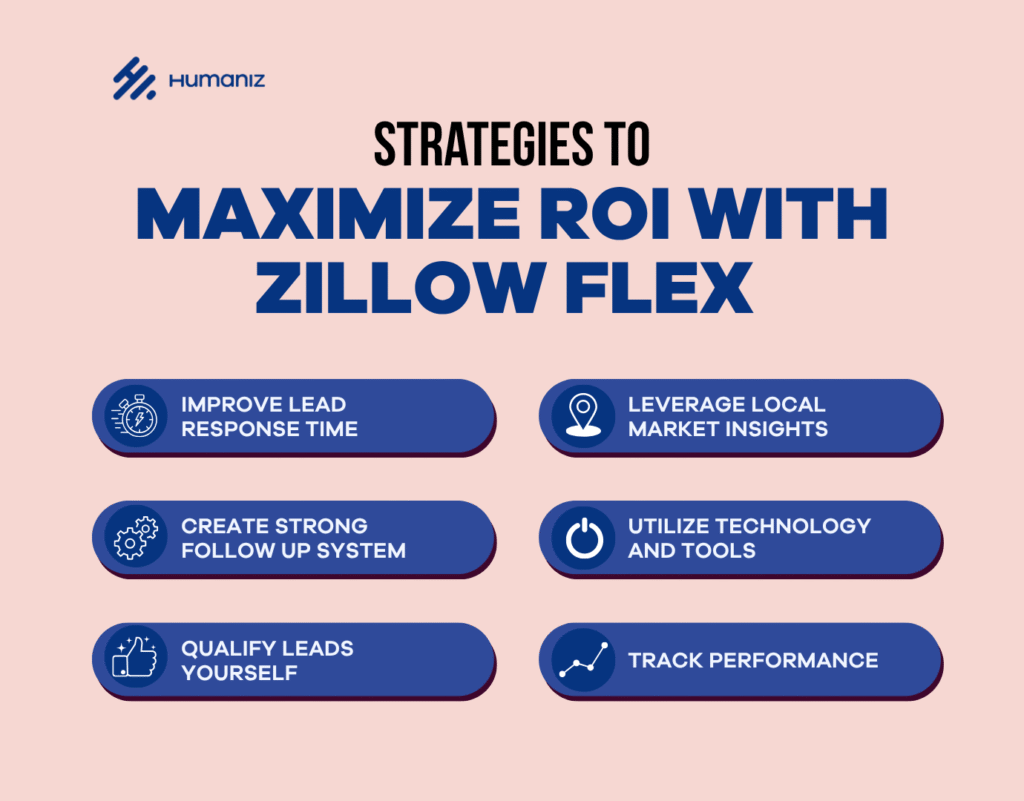We’ve all been there with various subscriptions. Things that seemed worth the money at the time, but left you wondering: “Why am I paying for this?”
Professional costs are no different. Many real estate agents use various tools to help them find, nurture, and close leads. Plenty of platforms work based on a subscription model or upfront fees, but it’s easy to tire of those if you’re not getting the results you want.
Zillow Flex claims to be different, working off a success fee structure (where you only pay for leads that eventually close). In this post, we’re answering all your questions about Zillow Flex costs and how Zillow Flex pricing actually works.

What is Zillow Flex?
Flex is Zillow’s performance-based program that makes it easier for service-oriented agents, brokers, and teams to grow their businesses. To be invited to participate, agents must meet several specific criteria and have a proven record of performance. Zillow Flex passes along high-quality leads, and agents pay a portion of their eventual commission back to Zillow. They call this a “success fee”, and we’ll explain it below. For a full breakdown of eligibility, performance standards, and long-term considerations, you can review our detailed guide on the Zillow Flex Program to see if it’s the right fit for your business.
You can also explore our other articles on the various aspects of Zillow Flex.
How Does Zillow Flex Pricing Work?
Let’s dive into the nitty-gritty of the success fee model. This isn’t your grandma’s traditional commission structure. With Zillow Flex, you’re not shelling out money upfront just to have your name on a fancy platform. You only pay a success fee when you close a transaction.
Referral fees are calculated based on the property’s zip code and sale price and can vary widely. You’ll find key pricing differences between buyer and seller transactions. For example, selling a mansion in Malibu might cost you a little more in fees than selling a cozy studio in a smaller city. And don’t forget location, lead type, etc.
The Referral Fee Structure
Let’s talk about real numbers. The typical referral fee percentages can range anywhere from 15% to 40%, usually around 35% of your commission (depending on your market). As with most things in real estate, location is everything. Different markets can expect different referral fee percentages.
Competition plays a role too. In a bustling market like New York City, those referral fees might be higher than in a quieter town. And stay on your toes—recent changes or increases in Zillow Flex referral fees could sneak up on you if you’re not paying attention to the latest terms.
Agents don’t pay any upfront costs and there are no ongoing subscription fees. You will want to understand the potential fee for each commission and manage your pipeline accordingly. For more specifics, you can check out the Success Fee calculator on Zillow.
Comparing Zillow Premier Agent with Zillow Flex Pricing
If you’re familiar with Zillow Premier Agent, you might be wondering how Flex is different.
While Premier Agent charges an upfront ad spend, Flex lets you pay only when you close the deal. It’s like choosing between a monthly gym membership (Premier Agent) and a pay-per-use training session (Flex). For a deeper breakdown of the two approaches, see our guide on zillow flex vs premier agent to understand which program makes the most sense for your business.
There are pros and cons to each model. While Flex might sound appealing with its no upfront costs, it can also mean higher success fees that eat into those hard-won profit margins. Think about which model aligns best with your business style—are you a go-getter who thrives on closing new deals, or do you prefer the security of upfront investments that you can predict?
The Pros and Cons of Zillow Flex Pricing
It’s not easy to determine where to invest your limited resources. Many agents rely on certain platforms to bring them leads or beat out other agents in a competitive space. It’s best to know the positives and potential pitfalls of any such platform so that you can make smart decisions.
Pros of Zillow Flex Pricing
- No Upfront Costs–Most agents agree that the biggest advantage of the Zillow Flex model is that they don’t have to pay upfront marketing costs. This means you can allocate your budget to other areas of your business or save it for future investments. It’s a low-risk way to get started with lead generation.
- Pay-for-Performance Structure–With Zillow Flex, you only pay when a transaction closes. This success fee model means that your costs are directly tied to your performance. If you’re effective at converting leads, you won’t be out of pocket for marketing that didn’t yield results. And if you don’t close the lead, no worries.
- Access to Quality Leads–Zillow is currently the most popular real estate platform, attracting many potential buyers and sellers. Using Flex, agents can tap into a steady stream of leads demonstrating interest in real estate, increasing the likelihood of conversions.
- Flexibility–As the name implies, the Flex program allows agents to adapt their strategies based on market conditions and personal performance. You can scale your involvement based on how well you’re closing deals, making managing your budget and resources easier.
Cons of Zillow Flex Pricing
- High Success Fees–While the lack of upfront costs is appealing, some say that Zillow Flex costs can be pretty high, ranging from 25% to 35% of a commission. This can significantly affect your profits, particularly on larger transactions, making it essential to be mindful of your overall income.
- Pressure to Perform–Since you only pay when a transaction closes, there’s a lot of pressure to convert leads quickly. Plus, there are those success metrics to meet, with the risk of losing access to future leads if your performance dips.
- Limited Control Over Leads–With the Flex model, agents don’t have control over what they’re getting for their investment. For example, you could get leads not perfectly aligned with your niche.
- Variable Lead Number–Unlike some formats that promise a certain number of leads each month, Flex only shares highly qualified leads. That means the number of leads agents get could change from month to month, making it hard to forecast.
Agent Strategies to Maximize ROI with Zillow Flex

So, you’re ready to dive in! You’ll want to hit the ground running and start nurturing leads as soon as possible. Here are a few tips.
- Improve Lead Response Time–Studies show that one of the most critical factors in converting leads is how quickly agents respond. Reaching out within the first few minutes significantly increases your chances of making a connection. You can use notifications or automated alerts to help.
- Create a Strong Follow-up System–Having a robust nurturing system is crucial. Use your CRM or the one offered by Zillow to track your leads, set up reminders for future comms, and make notes on your interactions. You can also set up a schedule for follow-ups and create alerts for reminders.
- Qualify Leads Yourself–Though the leads that Zillow Flex provides are already considered more likely to convert, you should review yourself for seriousness, readiness, and alignment with your own market/expertise.
- Leverage Local Market Insights–Prove that you are knowledgeable on the specific market the lead is interested in. Provide value like trends or data on the neighborhood. You can also create helpful content like videos or infographics about particular locations.
- Utilize Technology and Tools–Take advantage of the different tools available to help you streamline your processes. Automate whenever possible, and use video conferencing and docu-sign technology to get things done faster.
- Track Performance–Regularly review your work to identify areas for improvement. Monitor key metrics (especially those that Zillow tracks) like response times, conversion rates, etc. Then you can adjust your strategy (or even stop using the platform if deals aren’t closing).
The Impact of Pricing on Real Estate Agents and Brokers
High referral fees can hit solo agents harder than a double espresso on a Monday morning. If you’re part of a team structure, you might have more breathing room, but it’s still a conversation worth having.
Long-term financial planning is essential too. With Flex pricing, consider how those referral fees will impact your bottom line over time. Planning ahead can prevent those “uh-oh” moments when the bills come due.
Considerations for Brokers
Brokers, take note: managing agent commissions and costs is key to keeping everyone happy and profitable. Proper forecasting is particularly important. You need a plan for how leads will be dispersed to agents, what will happen if leads dry up for a time, etc.
It’s important to understand what is in the pipeline, how likely each deal is to close, when agents will receive their commissions, and how much Zillow will be owed. Only by keeping careful track of all potential deals and the financials associated can you have a real handle on your brokerage’s overall profits, forecast, and budget.
Alternatives to Zillow Flex
If you’re starting to think that Zillow Flex might not be your cup of tea, fear not! There are some alternatives that you can explore. Other referral-based platforms like Realtor.com, Opcity, and ReferralCloud are out there, each with their own pricing structures. Compare the key differences and consider when it might be time to switch gears and try something new (we also cover this in our previous post).
Zillow Flex pricing has its quirks, advantages, and pitfalls. As you decide whether to jump on the Flex bandwagon, remember these key takeaways: know your numbers, understand your market, and always have a backup plan. Balancing lead generation costs with potential returns will become your new normal–and it’s one that most agents agree is worth it.


